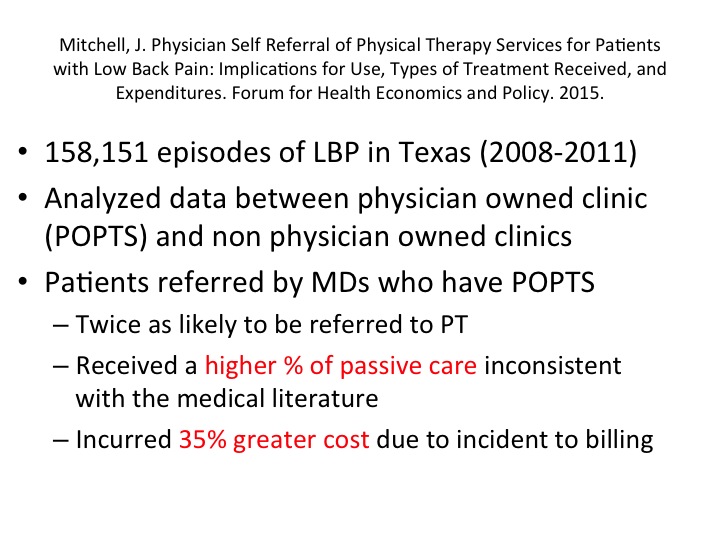Currently, consumers have many choices of where to obtain Physical Therapy services for their pain and sports injuries. One option includes a clinic owned by the physician, often an orthopedist or physiatrist, who refers the patient to the clinic in which he/she has financial ownership. This arrangement, described as a physician owned physical therapy service (POPTS) has been around for decades as physicians try to increase revenue within their practices. Unfortunately, this arrangement comes with a higher cost and poorer outcomes for patients.
Mitchell et al. (JAMA, 1992) was one of the first researchers to describe the limitations of these arrangements as compared to privately owned Physical Therapy services. The authors reported patients who were seen at a POPTS used 45% more visits at a 30-40% greater cost for the same diagnosis as compared to a PT owned practice. Often this care is associated with a greater utilization of less educated and trained providers including Physical Therapist Assistants (PTA), aides, or technicians (Resnik et al. Health Res Ed Trust. 2006). In comparison clinics who utilize only Physical Therapists document superior outcomes to those using more Physical Therapy extenders.
An interesting study was just published looking at these two clinic settings in relation to patients with low back pain (LBP). Mitchell et al. studied 158,151 patient visits for low back pain in Texas between 2008-2011 to determine the impact of clinic ownership on patients outcomes and cost. Consistent with prior research, if a patient was referred to a clinic in which the physician had financial ownership he/she experienced a higher percentage of passive care including modalities like ultrasound as well as 35% greater cost per episode of care. The utilization of passive care for low back pain is inconsistent with the latest medical research advocating for active treatments to reduce pain and disability and likely creates a longer episode of care for patients suffering with low back pain symptoms. The greater cost is attributed to the use of “incident to” billing in physicians offices which allows them to bill a higher rate for the same service.
The evidence has been consistent with POPTS, when physicians have an ownership in a service whether it be an MRI scanner or PT clinic the utilization of these services increases. In regards to POPTS, this increased utilization comes with poorer outcomes and an increased cost. If you are referred to Physical Therapy you always have a choice on where you obtain these services. I encourage you to do your research and find a local, knowledgeable PT.


